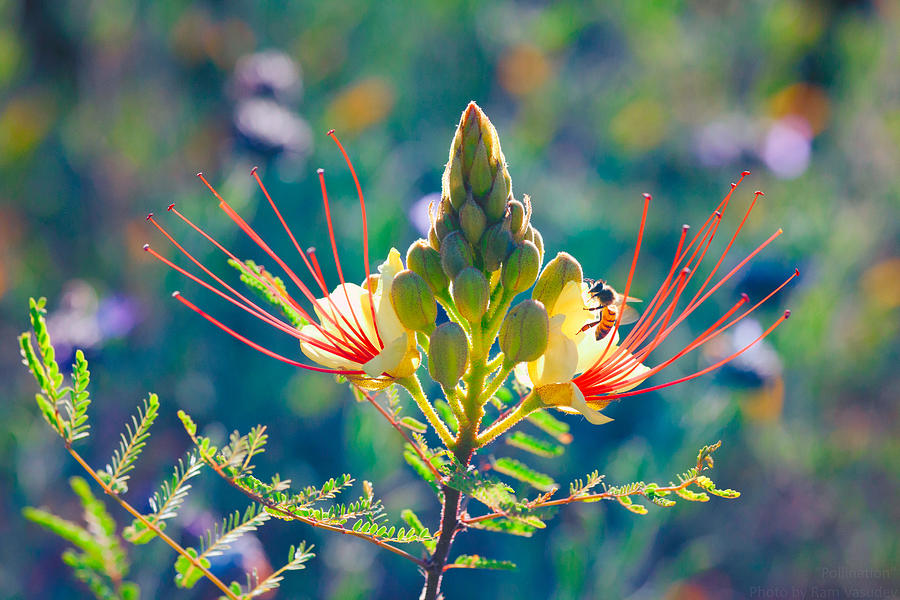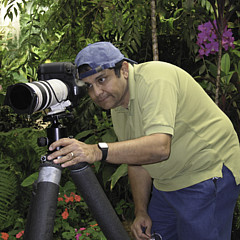
Pollination

by Ram Vasudev
Buy the Original Photograph
Price
$800
Dimensions
5616.000 x 3744.000 pixels
This original photograph is currently for sale. At the present time, originals are not offered for sale through the Ram Vasudev - Website secure checkout system. Please contact the artist directly to inquire about purchasing this original.
Click here to contact the artist.
Title
Pollination
Artist
Ram Vasudev
Medium
Photograph
Description
"Pollination" - nature photography by Ram Vasudev
A honey bee doing its thing (pollination) in a flower meadow, back-lit by the morning sun. I was attracted to this composition by the bokeh of out-of-focus colorful flowers in the background.
The plant here is Erythrostemon gilliesii, a shrub in the legume family. It is native to South America. It is naturalized in southwestern United States and Texas.
A honey bee is a member of the genus Apis, produces and stores honey and builds perennial colonial nests from wax. Honey bees represent a small fraction of the roughly 20,000 known species of bees. Bees are generalist floral visitors, and pollinate a large variety of plants. They have been used extensively for commercial pollination of crops and other plants. These pollination services are worth billions of dollars. Bees collect 66 lb of pollen per year, per hive.
Products produced by bees include honey, nectar, beeswax, pollen, bee bread and propolis. Honey is the complex substance made when the nectar and sweet deposits from plants and trees are gathered, modified, and stored in the honeycomb by honey bees as a food source for the colony. Nectar, a liquid high in sucrose, is produced in plant glands known as nectaries. It is an important energy resource for honey bees and plays a significant role in foraging economics and evolutionary differentiation between different subspecies. Beeswax is secreted by worker bees from a series of glands on their abdomens. They use the wax to form the walls and caps of the comb. As with honey, humans steel beeswax for various applications. Bees collect pollen and carry it back to the hive. In the hive, pollen is used as a protein during brood-rearing. Bee bread is a highly nutritional derivative, made from pollen by bees. Propolis (bee glue) is made from resins, balsams, and tree saps. It is used in tree cavities to seal cracks in hives.
Thanks to the following groups for featuring this photo:
(1) Wildlife one-a-day, 08/24/2015
(2) Wisconsin wildflowers and scenery, 08/24/2015
(3) Visions of spring, 08/24/2015
(4) Nature Photography, 10/16/2015
(5) USA Photographers, 11/10/2018
(6) Art District, 08/29/2022
Image copyrighted
© Ram Vasudev
All rights reserved
This work is protected by US and International Copyright laws. Do not steal this art by downloading to a computer, printing, copying (including screen capture) or reproducing in any form. It is illegal to do so and all infringements will be pursued to the full extent of the law.
Uploaded
August 22nd, 2015
Statistics
Viewed 2,646 Times - Last Visitor from Fairfield, CT on 04/24/2024 at 4:35 AM
Embed
Share
Sales Sheet
Comments (58)

Pamela Williams
Bravo, your outstanding work has been featured on the homepage of the FAA aRt diStrIct! You are invited to archive your work in the feature archive discussion

Jeff Burgess
You have so so many wonderful creative work in your port. I'll be back for more, but at the moment this particular capture caught my eye. It is quite beautiful and well photographed. L/f

Pamela Smale Williams
Fun coincidence, I just liked a watercolor with this same flower as part of its still life subject, you should see it, quite a similarity. I'm sending the artist link by email so you can see. That said, this is cheery and beautifully captured in its setting Ram. Lovely light & bokeh. V/ twt = @BoomerPamela_TX :) Pamela Artography











































































